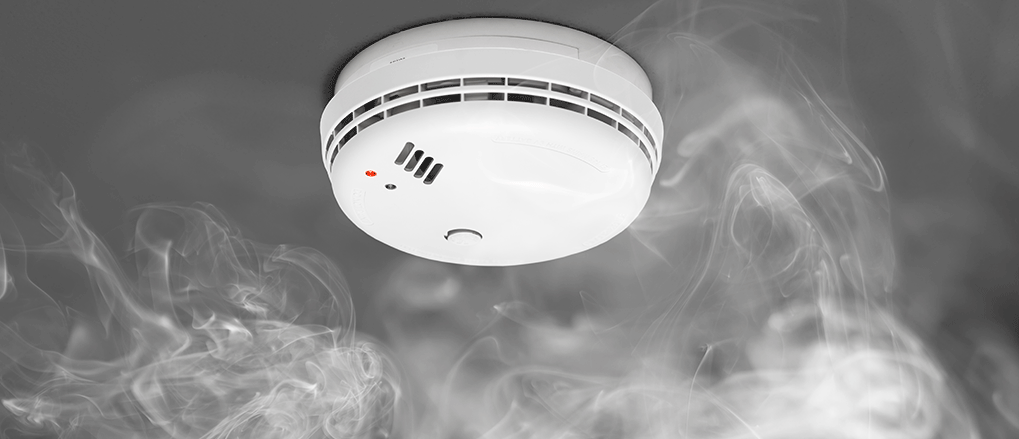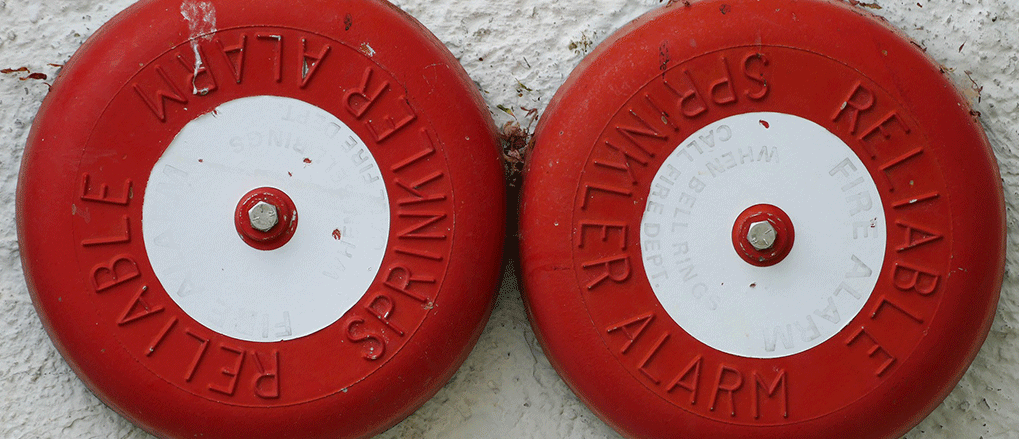When most people imagine fire alarms, they think of bells, sprinklers, and the common smoke alarms found in just about any home. Modern fire alarm systems are much more than these things.
It is safe to say that any sensible home-owner or business owner is aware of the importance of a fire alarm system. What many do not know is the range of options and possibilities for fire alarm systems that are now available.
Fire alarm systems are just as caught up with modern technology as any other security system. There is much more to fire alarm systems that most people know, and this guide is designed to help you understand the range of options when it comes to choosing a fire alarm system.
What are fire alarm systems? How do modern fire alarm systems work? What are the requirements for fire alarm systems? And what is the right fire alarm system for your home or business?
What is a fire alarm system?

A fire alarm system is designed to alert you and/or emergency services to any emergency that may include or lead to a fire. Fire alarm systems are routinely installed in homes, businesses, factories, and public buildings. Indeed, most structures are now required by law to have some type of fire alarm system.
Fire alarm systems include smoke, heat, and fire detectors which trigger a response at a central hub. This will set off audible warnings and light signals. The central hub can also be linked to emergency services. Some fire alarm systems also include sprinkler systems designed to inhibit the spread of fire.
How do fire alarms work?
The center of a fire alarm system is called the fire alarm control panel. This is essentially the brain of the system. All detectors are wired to the fire alarm control panel which can provide the status of the entire system to users.
The fire alarm control panel is linked to smoke detectors and other electronic detectors that are strategically placed throughout the building or structure. When any of the detectors are activated, the signal sent to the central control panel will alert users of the precise site of the detector and the nature of what has been detected, whether it be smoke, fire, or even carbon monoxide.
Fire alarm systems operate using different types of detectors and call points. These detectors and call points include:
- Heat detectors
- Smoke detectors
- Carbon Monoxide detectors
- Multi-sensor detectors
- Manual Call Points
Each of these detectors is linked to the central control panel so that any issue at any point can trigger the alarm. A loud bell or a siren sometimes accompanied by blinking or flashing lights for individuals who have hearing problems, blasts to alert occupants in the building. Many fire alarm systems also have ways of setting the alarm off manually. These manual points are also linked to the central control panel so that users and emergency services can locate the site of the original alarm.
Types of fire alarms systems
There are three basic types of fire alarm systems. Each operates on a primary method of detection and signaling. The three types of fire alarm systems include:
Ionization
Ionization fire alarm systems are primarily for detecting actual fire. These systems contain a small element that is situated between two electronically charged plates. Open fire or flames will ionize ambient air. This means ions are dispersed in the surrounding environment.
The elemental core situated between the electronic plates will detect the presence of these ions in ionization fire alarm systems and the ions disrupt the electronic pulse between the plates and the core. This will subsequently send an electric current to the system which triggers the alarm.
Photoelectric
This type of fire alarm system is better at detecting smoldering fires before they become open flames. Since a smoldering fire will give off smoke before the flames begin to burn, it can detect the presence of a fire before you have a larger problem.
A photoelectric fire alarm system uses a beam of light that is sent out from a light sensor. When smoke is present in a specific area, it will reflect in the beam of light which triggers the alarm.
Combination
A combination alarm system utilizes both ionization detection technology and photoelectric technology. The argument for this type of fire alarm system is that it provides maximum protection in the event of a fire. However, the combination alarm system does not work quite as well as the presence of both an ionization and photoelectric systems set up separately.
Because both ionization and photoelectric smoke alarms are better at detecting distinctly different yet potentially fatal fires, and because no one can predict what type of fire might start in a home, the USFA recommends that every home and place where people sleep be equipped with either (a) both ionization and photoelectric smoke alarms, or (b) dual sensor smoke alarms (which contain both ionization and photoelectric smoke sensors).
When is a fire alarm system required?

According to the National Fire Protection Association, the main sites that require a fire alarm system include:
- Educational occupancies
- Detention and correctional occupancies
- Assembly occupancies
- Business and mercantile occupancies
- Storage and industrial occupancies
Individual states have further requirements. The Florida State Building Code details the precise requirements for fire alarm systems in the state.
Every existing home should, at a minimum, have one smoke detector outside each sleeping area and on every level of the home, including the basement. The current Florida Fire Prevention Code requires dual powered (battery and house current) smoke detectors, inside and outside each sleeping room and on every floor level for new construction. On floors without bedrooms, detectors should be installed in or near living areas, such as dens, living rooms, or family rooms.
Fire alarm systems produce what type of signals?

The three main signals on your fire alarm system control panel are alarm, trouble, and supervisory. By learning to read these signals you can avoid both problems with your system and undue worry when there is nothing to be concerned about.
Alarm signals mean something has triggered the alarm system. This means there is some fire source that needs to be attended to. Some indicators will show a false alarm which can be the result of improper maintenance, dirty smoke alarms, or an improperly set water flow switch.
Trouble signals indicate that there is an operational issue. These might include:
Power
Does the alarm system have power or did the power recently blackout? Make sure that the breaker did not accidentally shut off, as it is a commonly overlooked issue.
Batteries
If the fire alarm batteries have not been changed in the last 3 to 5 years, they may be below capacity and should be replaced. Their connections should be checked as well.
Voice Over IP Switch
Recently, facilities have been upgrading from copper lines to voice-over IP. It is sometimes forgotten that the fire alarm is connected, which then does not allow the system to complete its daily test. This also means that no one would be able to dial out in the event of an emergency.
Ground Fault
There are a few different reasons why a ground fault would occur. A bare wire could be touching something in the junction box, a wire could have been cut or loosened, or a lightning strike could cause circuit issues.
Supervisory signals indicate that there is something wrong with the systems that monitor your fire alarm system. This means you should alert the professionals who maintain your system. Common issues for a supervisory signal include:
Sprinkler Valve
Sometimes a sprinkler valve is accidentally left open after a maintenance check.
Low-Pressure Switch
Has your compressor stopped working? Sometimes a small hole in the pipe can allow air to escape and will not allow the compressor to meet the demands of the system.
Duct Detectors
Sometimes duct detectors are activated when air conditioning or heating has been turned off for a while, then turned back on. High humidity and condensation from air conditioning and dust burned on heating coils from heating can both cause this problem.
Fire alarms systems FAQs
What is a fire alarm system?
A fire alarm system is designed to alert you and/or emergency services to any emergency that may include or lead to a fire. Fire alarm systems are routinely installed in homes, businesses, factories, and public buildings. Indeed, most structures are now required by law to have some type of fire alarm system.
What are the three main types of fire alarm systems?
The three types of fire alarm systems are ionization detectors, photoelectric detectors, and combinations detectors. Each system has its advantages. For the most security, you would install both ionization and photoelectric system.
How do fire alarms work?
Fire alarm systems work when detectors of various types, for example, smoke alarms, fire detectors, heat detectors, and carbon monoxide detectors, are linked to a central control panel which will trigger alarms and alert emergency services.
When is a fire alarm system required?
Fire alarm systems are required in educational occupancies, detention and correctional occupancies, assembly occupancies, business and mercantile occupancies, and storage and industrial occupancies. Always check local building codes to make sure you are complying with local ordinances regarding fire alarm systems.
What are the three main signals on a fire alarm system?
The three main signals on your fire alarm system control panel are alarm, trouble, and supervisory.
Circle Security Solutions Product Showcase
Commercial fire alarm systems
Do you have the required protection and certifications for your business’s fire alarm system? Do you conform to the local fire and building codes, central station monitoring, UL/ETL certifications, and runner response?
Circle Security Systems will install the most reliable and comprehensive systems available on the market today. Whether you have a large retail operation, warehouse, or small business, commercial fire protection, and life safety have to be your number one consideration.
We are ETL-listed and will provide the necessary CAD drawings and submittal packages required by all local municipalities. Worried about annual testing & certifications? We can handle all of that for your business, so you’ll always be up to code.
Residential fire alarm systems
Circle Security Solutions employs state-of-the-art fire & smoke detection technology to provide South Florida residents with the best of the best in residential fire systems.
We custom design a fire detection solution that keeps you, your family, and your belongings protected and safe. Your home will always be within fire code and pass any inspection.
Conclusion
The best way to protect your home or business from fire is with a professionally installed fire alarm system. And the fact is, fire alarm systems are required by law in many types of buildings and businesses. Fire alarm systems save lives and save property by making sure emergency services are on the scene in the event of a fire.
Fire alarm systems have progressed significantly since the days of simple bells that were triggered by hand. Contemporary fire alarm systems are centrally controlled with multiple sites for detecting smoke, fire, and heat. These modern fire alarm systems will let you know there are signs of a problem well before there is a tragic situation.
What is more, modern fire alarm systems are designed to effectively troubleshoot themselves. If there is a problem anywhere in the system, the system itself will detect the problem so you or professionals can repair it.
Even if you are not legally required to install a fire alarm system, you owe it to yourself to protect you, your loved ones, and your assets with a professional and modern fire alarm system. There are fire alarm systems designed for the home that can be made to fit your needs. Do not leave things to chance when it comes to fire security. Have professionals with Circle Security Systems help you evaluate your needs and install a modern fire alarm system.


